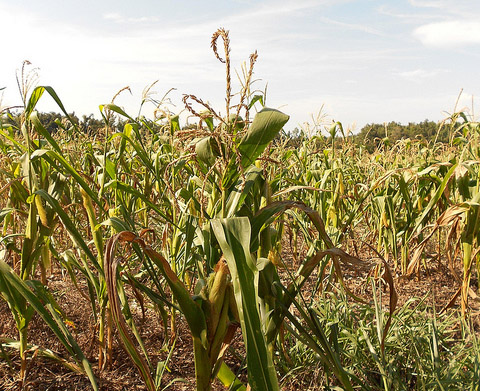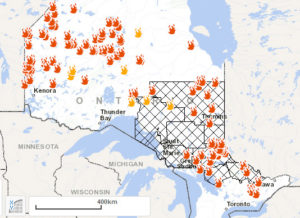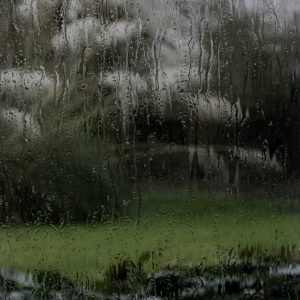Too dry to too wet; summer weather extremes in Ontario and Quebec
Trouble on the farm

Drought stressed corn. Photo: CraneStation, Creative Commons, some rights reserved
It’s been a couple of weeks of extreme weather extremes in eastern Ontario and western Quebec. Most of July has been hot and dry and June wasn’t going much better. The South Nation Conservation Authority, the agency responsible for the South Nation River watershed east of Ottawa, issued a Level 1 low water condition based on Environment Canada data showing precipitation over the past three months in the region as 60 to 76 per cent below normal. Farmers were getting worried; too. “It’s extremely dry right now,” said Réjean Pommainville, a cash-crop farmer east of Ottawa who also represents Prescott, Russell, Glengarry, and Stormont counties on the board of the Ontario Federation of Agriculture (OFA). He said the first cut of hay at the end of June was good and he recently completed a second cut. He said that without rain, it will be difficult to get a third cut. “We need a good soak,” Pommainville said, noting conditions have been warm and windy, which make things worse for crops, and that hot weather causes stress on livestock too. The Union des cultivateurs franco-ontariens (UCFO) represents francophone farmers from the local region and across Ontario. “The corn is very, very dry,” said spokesperson Geneviève Souligny. She said most farmers had a good first cut of hay, but some were even struggling to get a good second cut due to the lack of rain.
Flames in the forests

New and active forest fires in Ontario. Map: Ontario Ministry of Natural Resources and Forestry
The dry weather has caused a dangerous threat of brush and forest fires across Ontario and Québec. Most municipalities issued bans on open fires over the past two weeks, or partial bans were issued that only allowed small campfires in designated places for the evening hours. The hardest hit regions have been the Temagami area north of North Bay, the French and Key River areas south of Sudbury, and the Bissett Creek area between Algonquin Provincial Park and the Ottawa River. Evacuations were ordered along the Key and French Rivers, which includes several camps and First Nation communities. The Canadian Broadcasting Corporation (CBC) reported that the fire in that area was allegedly caused by overheating equipment being used to construct wind turbines in the remote area but the Ministry of Natural Resources and Forestry (MNRF) removed the cause of the fire as being “human” from its website. Other causes of fires were lightning strikes. According to the MNRF, there have been 813 forest fires in Ontario so far this year, up from 221 in 2017. 114 fires are currently active across the province. Forest firefighting crews from other provinces, states, and even Mexico have traveled to Ontario to help out. In Québec, SOPFEU (French only link), the provincial forest fire protection agency, reports there have been 456 fires across Québec this year but only seven are active right now. Most of them are in the northwestern part of Québec, including areas that border the hard-hit parts of northeastern Ontario.

Heavy rain. Photo: Brett Jordan, Creative Commons, some rights reserved
Soggy situation
In the past few days, conditions have gone from too dry to too wet though in many places. In Ottawa and Gatineau, it rained everyday from Sunday to Wednesday, and almost for 24 hours from late Tuesday afternoon to late Wednesday afternoon. The CBC reported that 2.4 inches/60 millimeters of rain fell at Ottawa airport on Wednesday, breaking a record of 1.6 inches/41 millimeters set in 1969. Over 3.3 inches/85 millimeters was recorded nearby at the Central Experimental Farm. Storm sewers were overwhelmed in many areas and vacant lots turned into ponds. The good news is though that very brown looking grass, withering leaves on trees got some much-needed moisture, and hopefully the forest fire situation will dampen a bit, too.
We really have gone from one extreme to the other with extreme weather!
Tags: canada, farming, forest fires, Ontario, Quebec, rain, weather







